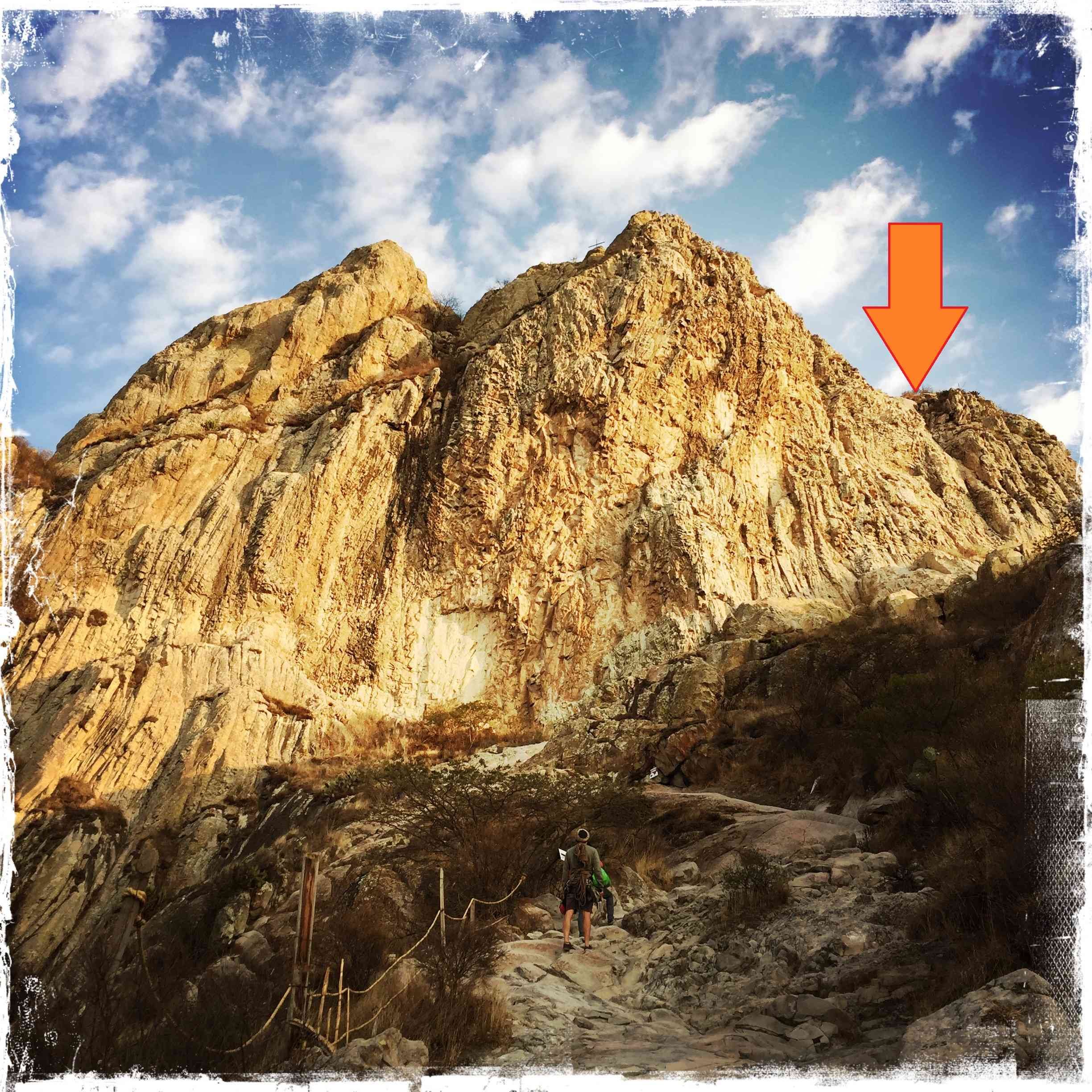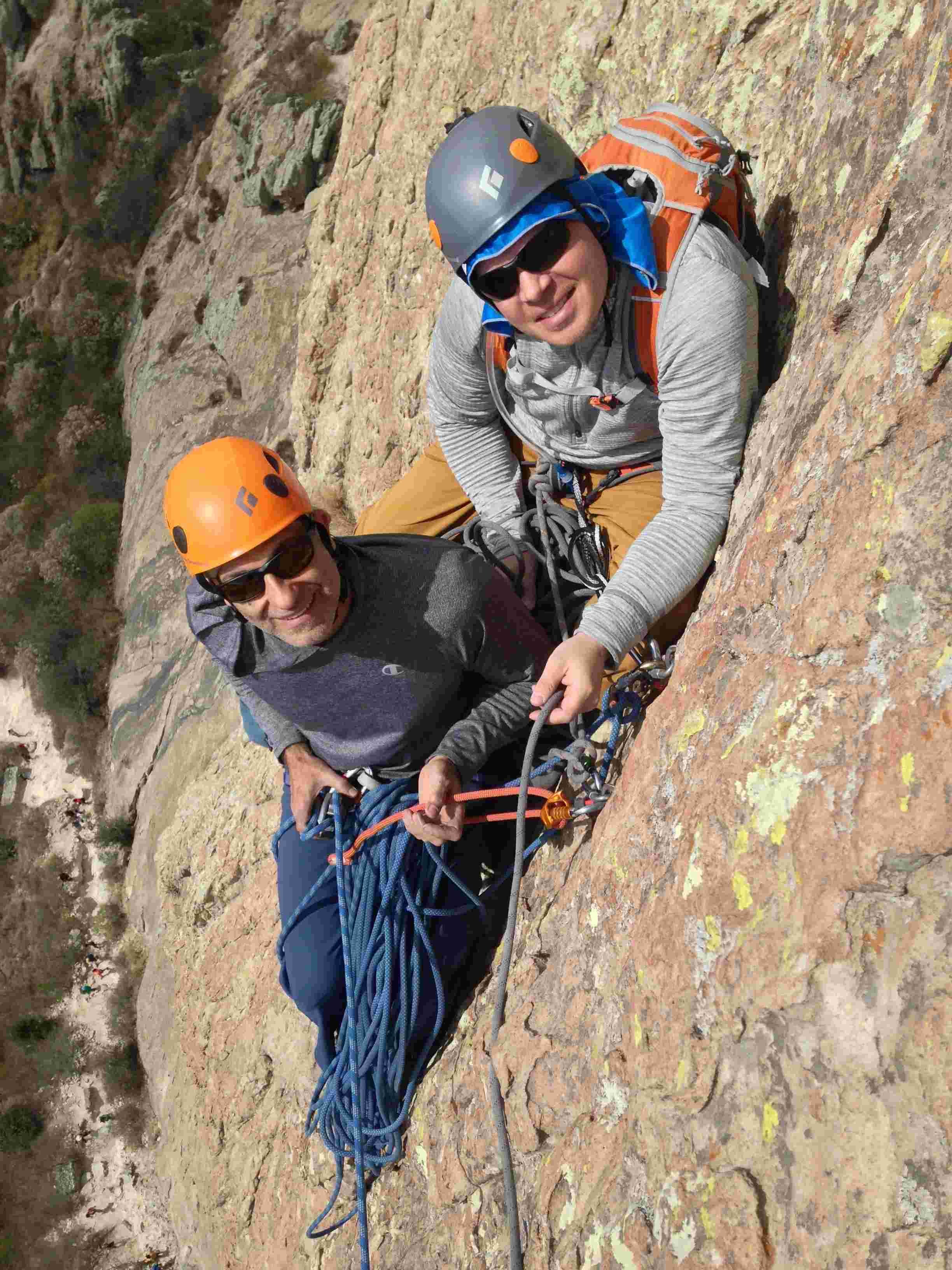Pena de Bernal from Chichi’dho
When it comes to tourism Peña de Bernal is the focal point for all of the State of Queretaro in Central Mexico. As far as climbing destination it is the focal point for all of Mexico and the World as there are very few areas that are similar. At just over 1,900 feet tall Peña de Bernal is the tallest free standing monolith in the World. For the town of Bernal it attracts tourists from all over who desire to hike the Memorial Trail and spend time in one of Mexico’s most eclectic towns.
This is a story of the new incoming administration that controls the monolith, eco-tourists ascending the via ferrata, climbers and the rappel line traditionally used to get anyone spending their day on the wall back to the ground safely.
When two cultures collide:
A little background information on the Monolith~
Way back in 1920 there was a Via Ferrata constructed on La Peña to allow visitors an unobstructed view from the top of this majestic pinnacle of the valley below. The orange arrow delineates where the classic rung route ends, and where climbers would naturally rappel when the climbing day has been concluded.
The classic Memorial Trail hike. Well worth visiting Bernal just to do this short thirty minute approach for outstanding views of the valley below
So as climbing, and tourism gained in popularity so did the number of visitors to Bernal. There are roughly ten multi-pitch climbing routes that summit the monolith and a plethora of variations to gain the main lines to the top.
Peña de Bernal. Great stone, and equally superb routes.
The Via Ferrata has seen much commercial success over recent years as the ease of ascent and subsequently descent gives many more people not prepared to climb technically access to the summit. So on any given day we have a mix of climbers and commercial Via ferrata trips at the rappel station up top waiting to return to the ground. All the while tourists are happily frolicking sixty meters below. This influx of summit visitors has eroded the upper descent trail that deposits everyone at the main rappel station high above the hikers below. Honestly, this trough from the summit trail leading to the anchor chains was never really set up from the beginning to handle traffic and this issue could have easily been remedied, but as you will read is all part of the story.
The 1920’s Via Ferrata, and clients simil-rapping the descent trough. The pristine quality of the Porphyritic Granite is spectacular for technical climbing.
Part 1: My return from the states.
So within a short time of returning to my home in Mexico I ventured over from my town of Aculco (ninety minutes south) to the shady side of the monolith to visit my good friend Fernando. This is where our adventure begins.
The shady side of the monolith is home to Chichi’dho a beautiful eco-tourism camp and hostel for adventure travelers. The Landin family owns the property and has been slowly transforming the area to a magnificent landing for any traveler who finds themselves in the state of Querétaro.
Whenever I guide the monolith Chichi’dho is where I choose to stay. Not only because of the natural setting and tranquility but for the friendship I have built with the Landin family. They are fantastic people who have a vision for the property and México as a whole. Young Fernando being a great friend and always has sage advice whenever I have questions regarding the people and culture of such a beautiful country is always a pleasure to spend time with. To know Fernando is to like him.
If you find yourself in the state of Queretaro and you enjoy the outdoors, visit Chichi’dho. This eco tourist resort.is setting standards way ahead of its time for preserving land for the future within the country of. México.
On this particular visit Fernando actually had been waiting for my return so he could explain to me how the the town of Ezequiel Montes (overseers of the monolith) were rumbling about closing the area for climbing as they saw no real benefit of this user group vs. the rock fall threatening tourists where the Via Ferrata deposits anyone going vertical back on the ground. The tourists were being put in the path of projectiles being kicked free from visitors (who know nothing about being cautions with rock fall) descending the via ferrata with a commercial guiding group. This descent is by far the easiest as you can start routes anywhere on the monolith climbing upwards for up to eleven pitches and grab the ferrata rap for one easy 65 meter rappel with two 70 meter ropes tied together. After climbing eight hours or more a 30 minute rap is really nice.
Ezequiel Montes wanted the rappel moved out of the area so anyone on their way down wouldn’t put hikers at risk.
Move the rappel? This would be a huge logistical undertaking to say the least…. The monolith is about 2,000 feet tall and not all of it is vertical. Having multiple steps on the wall would complicate matters as would trying to clean an entirely new retreat. Holy cow! There has got to be a better way?!
Fernando, his brother Omar and I met with the representatives from the town and I implored them to clean the existing line as the debris laying in wait was the issue and it could be remedied so the via ferrata visitors wouldn’t create more issues. Nope. My pleas fell on deaf ears…. They were convinced that a) it was climbers not via ferrata people, and b) that this is what they wanted and there would be no further discussion. Well….. I figured poking a nest of bees never turns out well for the one holding the stick so we best appease the powers that be and figure it out.
The red arrow being the via ferrata, the orange arrow being the [agreed upon] location of the new rappel and the green arrow is where the rappel ended up happening. Keep in mind that the wall under the green arrow is +- 800 feet tall.
So after much discussion we agreed with the town to move the rappel to the very left of the memorial ledge to keep people below out of the path of falling rocks and also minimize the added strain on via ferrata traffic. Keeping in mind that for people not familiar with being around vertical cliffs; going up in one location and returning in another is much more complicated for everyone involved. The climbers? Well… realistically getting down is all part of the experience so a bit more of a rap wouldn’t be too cumbersome.
On our way up to the top. Eight of us in total. Five climbers and three people from the town.
What went on from the ground where we all agreed on the new rappel location to the summit of the monolith is still a mystery to me….
When Fernando reached me at the high rappel anchor he looked at me and said “plans have changed”. I was like what, huh? What plans? He proceeded to tell me that along the path up while climbing the metal rungs one of the main gentlemen from the town (who was free soloing) told him they wanted the location to be further left. Like, much further left…. I was in shock. Now we were all up top and we would have no idea where to stage the rappel looking down. So I went and found Jerry Daniels who was (equally involved as any of us) trying to figure out how to pull all the pieces together. I said “Jer, they want the rap way further left than we agreed on the ground”. He looked at me and got a blank stare as he knew we were now 2,000 feet up and just willy-nilly rappelling could get ugly and time consuming (as we were both on borrowed time from our daily lives). “What? Huh? No. No. Why? Who told you this?”. I said Fernando had a conversation mid-climb with the “mountain dudes” and laid it all out for him (the abridged version) from what I got from Fern.
Fernando and I talking about all the unknowns below us.
Fernando, Jerry and I talked to the representatives from the town and walked around at the summit for quite some time trying to figure out where exactly would be agreeable to the town. No more vague answers or unknowns as this was a serious undertaking and the work involved was going to be extensive. Almost like looking for water with a divining rod. They pointed and we tried to find a path of least resistance back to the ground. This time I was a little wiser and said well…. one of their guys is going with us. Everyone looked at me like I was nuts. Taking a person who never wore a harness down a fixed line to who knows where? Yeah well, we need answers to where they want the rap, no second guessing…. someone is joining us. Octavio was the town’s choice as neither of the other gentlemen would even consider it (this after they all free soloed the iron rungs).
Octavio and Omar getting ready to start the rappel.
We decided as a group that Jerry would go first and set anchors and I would handle all of the safety aspects of keeping all of us on the ropes and moving smoothly. This was going to be quite the adventure and without working together the entire plan could fall apart. Once an anchor was installed (with extra bolts to spread out the group) Jerry would communicate that it was safe to move our group 30 meters down a vertical cliff one rappel at a time.
Octavio headed towards what would be the new rappel line on Peña de Bernal. I love it when people absorb and follow directions. He understood where we were going and kept his hand on the brake like a seasoned climber.
Staging the next rappel.
Adventure to me is getting involved in the unknown. Jerry handled the drill and hardware, Octavio pointed the way, Fernando kept a clear line of communication encase something went awry, his brother Omar kept an eye on Octavio to make sure he didn’t do anything to endanger himself and I kept us moving safely down the line. Adventure at its best!
From left to right: Simeon Heimowitz, Fernando Landin, Octavio Urima, Jerry Daniels, Maikel Rosabal, and Omar Landin
The day went really well for not knowing what to expect. Octavio had an adventure of a lifetime and we established a new rappel line that would keep the climbers separate from the via ferrata while subverting any further issues with Ezequiel Montes and the mountain police. Two cultures that don’t understand one another found a way to work together for the better good of all.
At this point were we done? Not by a long shot…. The entire rappel line needed to be meticulously cleaned and a ledge had to be built at the top of the third rappel anchor staging point.
Omar, Joren De Smet and I building the grand traverse ledge.
We returned a few days later to secure a ledge system that would survive the test of time. As I explained to the group; if we don’t build the support structure the new rappel line will soon be worse than what people originally used on the via ferrata.
The finished product.
Public service. is a service intended to serve all members of the community. This project was a union of climbers, a local business and the county seat of Ezequiel Montes. Every part making up the whole.
Jerry and his lovely wife Annette supplied the hardware to make the anchors a reality. Omar, Fernando and Joren from Chichi’dho supplied the wood and wire to create the ledge system. The fine gentlemen from Ezequiel Montes, aka The Mountain Police helped carry all the materials to the base of the rappel so we could set up a haul system. We all worked together to make this project become a reality while creating a solid relationship between the climbers and the people who oversee the well being of the monolith.
We all gained from this experience and we are all better because of it. At first I was very hesitant to get involved with a project of such magnitude especially when it involves the local government. I am glad that I saw the entire process through as now I have a better understanding of the culture of the people here in Central México and have successfully built bridges between the climbers and those who oversee the mountain. Building bridges for the future.







![The red arrow being the via ferrata, the orange arrow being the [agreed upon] location of the new rappel and the green arrow is where the rappel ended up happening. Keep in mind that the wall under the green arrow is +- 800 feet tall.](https://images.squarespace-cdn.com/content/v1/57c16da1cd0f6844bcc4463d/1617653870261-17U8OJPUZGIPJPYEUV18/FullSizeRender+30.jpg)








